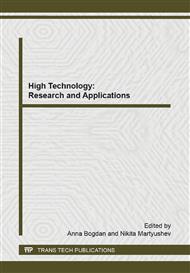[1]
M.M. Ibrahim, H.A. Al-Diyar, Synthesis and antibakterial activity of semicarbazone derivatives of some carbonyl compounds, Der Chem. Sinica. 2 (2011) 171-173.
Google Scholar
[2]
B. -O. Nilsson, Biological effects of aminoguanidine: An update, Inflammation Research. 48 (1999) 509–515.
DOI: 10.1007/s000110050495
Google Scholar
[3]
S.N. Pandeya , J.R. Dimmock , Recent evaluations of thiosemicarbazones and semicarbazones and related compounds for antineoplastic and anticonvulsant activities. Die Pharmazie. 48(9) (1993) 659-666.
Google Scholar
[4]
J.S. Casas, M.S. Garcı́a-Tasende, J. Sordo, Corrigendum to Main group metal complexes of semicarbazones and thiosemicarbazones. A structural review, Coordination Chemistry Reviews. 209 (2000) 197–261.
DOI: 10.1016/s0010-8545(00)00363-5
Google Scholar
[5]
H. Beraldo, D. Gambinob, The Wide Pharmacological Versatility of Semicarbazones, Thiosemicarbazones and Their Metal Complexes, Mini Reviews in Med. Chem. 4 (2004) 31-39(9).
DOI: 10.2174/1389557043487484
Google Scholar
[6]
M.J. Silva, A.J. Alves, Silene C. D. Nascimento, Synthesis and cytotoxis activity of N-substituted thiosemicarbazones of 3-(3, 4-methylenedioxy) phenylpropanal, Elsevier Science. 53 (1998) 241-243.
DOI: 10.1016/s0014-827x(97)00022-0
Google Scholar
[7]
A. Nizam, M.A. Pasha, Iodine-catalyzed, rapid and efficient, one-pot synthesis of 1, 2-dihydro-1-arilnaphtho [1, 2-e][1, 3] oxazine-3-ones under solvent-free conditions, Synthetic Communicatins. 40 (2010) 2864-2868.
DOI: 10.1080/00397910903320654
Google Scholar


